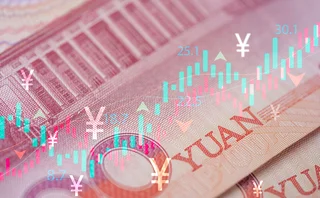
Markets Technology Awards 2022: the joy of flex
Tech users want the freedom to tweak and change their systems – not always an easy ask for rigid, legacy software

When Russell Feldman started working as an analyst in the bond trading department of what was then Deutsche Asset Management, he compared notes with his father, who had also spent time as a bond trader. Despite working in the markets at very different times – the younger Feldman started in the role about a decade ago – they both complained of clunky, inefficient systems that made their jobs harder and often meant they had to stay late at the office.
“Everybody in the bond market has this issue of massive inefficiency of workflow. I found the same problems [that he had experienced], and I was burning the candle at both ends,” says Feldman.
He didn’t stay in the job for long, and is now working at a tech vendor, trying to ensure future generations of Feldmans are not confronted with the same woes.
Over the past few years, many working in capital markets have started demanding more of the technology they use at work. Fed up with old-fashioned systems that need them to ring up a tech support desk to make basic changes, many traders and back-office staff are now pushing for systems that are more intuitive, easier to customise and have automatic workflows to save them time.
“Clients are demanding more transparency, more customisation – they want more control,” says Feldman, who is now chief operating officer at IMTC, a provider of fixed income investment management software.
The evidence of this year’s Markets Technology Awards suggest the message is getting through. Among the more than 190 submissions to the awards, innovation and user experience were a common theme, for large and small firms alike. From the back office all the way through to traders and portfolio managers, vendors are increasingly focused on making their products easier to use and more engaging – not an easy task for many legacy systems, which were not designed to be flexible (this year’s roll of honour, awards methodology and list of judges can be found at the bottom of the article).
No train, no pain
Ronen Kertis, head of global regulatory reporting at IHS Markit, has seen first-hand how client expectations are changing, and thinks this is driven partly by advances in consumer technology.
“We all want to get the technology to work for us. When was the last time someone trained you to use an app on your iPhone?” he says. “I know that if a system requires me to watch a one-hour video tutorial and then get people to explain how to work with it, I’ll try to minimise my use of that system.”
He says making products easier to use and more customisable is a “big focus” that “we invest heavily in”.
One example of a new function the team hopes will save clients time and provide new insights, is a business intelligence tool that allows clients to get into the weeds of their SFTR (Securities Financial Transactions Regulation) reporting – a new-ish European transparency regime for repo and securities financing markets. The tool enables users to create reports and charts for large volumes of complex SFTR data and benchmark their regulatory reporting against peers.
If a system requires me to watch a one-hour video tutorial and then get people to explain how to work with it, I’ll try to minimise my use of that system
Ronen Kertis, IHS Markit

Pierre Khemdoudi, senior vice-president, equities and regulatory reporting at IHS Markit, says: “We don’t want to be in the way of our clients. Instead of trying to create reports ourselves, we’re giving the power to our users.”
Generational trends
Rohan Douglas, chief executive of risk management software provider Quantifi, has also seen a shift in client expectations. He says a big reason for this is the pace of change in capital markets, which has left companies wanting to tweak systems – and frustrated if they have to wait weeks or months for vendors to make system upgrades.
“Our experience is that pretty much every client needs something a little bit different,” he says. “People have struggled with systems that are a bit older and bit more difficult to change or customise. So, I think clients are putting a lot of value in systems that are up-to-date and able to stay up-to-date with how rapidly things are changing.”
New generations of staff are also behind the shift, he adds. Traders in their thirties or forties may be happy to do many of their calculations in Excel, but younger traders increasingly want tools that allow them to do their own basic programming. As a result, Quantifi has been integrating coding tools into its services. The firm’s data science platform allows users to do analysis and create their own custom reports using Python and Jupyter Notebook. Users can also mix data sources from many different data providers and use third-party analysis tools, such as Power BI and Tableau, to create custom reports.
“There will be a bit of Python; instead of using Excel, it might be some data science tools. But this will be foreign to their manager. That transition is still happening and will probably take another five years to be as pervasive as it is outside of finance,” Douglas says.
This generational factor is something Ganesh Natarajan, chief operating officer of energy and commodities trade management software provider, Enuit, has also noticed. Over the past two years, he has seen decision-makers in the energy and commodities trading sector become younger and more tech-savvy than their traditional customer base.

Natarajan says these younger users have an “Alexa background” and expect systems to have easy-to-use workflows that automate processes, a clean user interface and minimal mouse clicks.
“A decade before if someone came to me and said, ‘I have a great product and it looks super nice’, my first answer would have been: ‘I don’t care if it looks nice, does it do number-crunching and can it manage my risk?’ But right now, that is not the case. People are interested in the user experience,” he says.
He points out the commodity trading and risk management space is never going to be able to compete with the user experience offered by consumer tech companies, like Apple or Netflix, but says vendors are still under pressure to make their product “more engaging”.
As an example, he says Entrade has integrated maps into its system, making it easier for users to see when shipped commodities will arrive at their destination and to plan for things like insurance.
“Let’s say a vessel is moving from Indonesia to Singapore. If I put it into a map, it doesn’t even have to be real time GPS, and I can see my vessel is here and the travel time will be three weeks. It makes it much more appealing,” he says.
Covid side-effects
The pandemic intensified some of these trends, and added new twists. Work-from-home orders prompted many technology providers to put more of their services on the cloud, while increasing the need for systems to be more intuitive – users could no longer ask a colleague at a nearby desk for some quick tech advice.
Oliver Jerome, co-founder of best execution analytics company BestX, says the shift to remote working pushed many of his clients to start using his platform in a different way, with many applying some existing functions for the first time. He compares the effect of the pandemic to flying a jumbo jet through fog. Often, market participants had fewer sources of information – just what they could see on their screens.
“Suddenly the fog has come down, and you are flying the jet just using instruments,” he says. “We gave them all the instruments pre-pandemic and they were using them, but also relying on what they were picking up on their own trading floors.”

Jerome says customisation will become increasingly important in the coming years – and there is still a lot that can be improved. He gives the example of best execution committee reporting, which many asset managers are required to submit quarterly. His team realised many of their clients were spending up to a week each quarter creating “pain in the backside” custom reports, despite all the sophisticated charts and custom pages the BestX system could provide.
Suddenly the fog has come down, and you are flying the jet just using instruments. We gave them all the instruments pre-pandemic and they were using them, but also relying on what they were picking up on their own trading floors
Oliver Jerome, BestX
“We found that clients were still screenshotting little bits of [our system] and putting it in their reports. So we thought, maybe we could save them a job,” he says, explaining that around 25 clients sent examples of their committee reports and, later this year, the firm will release a tool to generate a chunk of these reports, hopefully automating the process and saving clients valuable time.
Think of the vendors
All this effort may be good for the client, but it can be painful for the vendors.
“We’ve made a rod for our own back because it’s so customisable and therefore people need to understand how to customise it,” says Jerome. “It’s a complex piece of kit and the biggest issue is turnover of staff at the banks.” Each new intake requires a new round of training.
More than that – it could also leave vendors in a tough spot, burdened with unwieldy platforms that are difficult to update.
Back at IMTC, Feldman agrees that the issue of proliferation can be tricky to manage. But he says new cloud development tools make it easier for technology providers to come up with customisation tools quickly.
“Now the technology has caught up to deliver that type of customisation and deliver it in a reasonable way. We are using devops to reduce the amount of waste when it comes to development time. So, I think that allows us to put out an offering that is incredibly efficient, but not overwhelming for the user,” he says.
Feldman also argues vendors need to understand properly why clients are asking for a particular feature; this allows them to create features that work not just for one client, but for many.
“It is about asking the right questions to dictate what the actual outcomes are that people want to accomplish. That way we can work backwards to building a flexible enough solution that doesn’t just satisfy one use case but satisfies 95% of use cases.”
Markets Technology Awards 2022: the winners
The two big winners at this year’s awards were data and analytics providers Bloomberg and IHS Markit, who each took home awards in three categories.
The other awards were shared across a mix of big, established trading and risk vendors – such as Murex and Moody’s Analytics – and younger or specialist firms, such as BestX and Databricks.
An overview of the awards methodology and a list of the judges can be found below this year’s roll of honour.
TRADED RISK:
Counterparty risk product of the year: Quantifi
Market liquidity risk product of the year: Bloomberg
Market risk management product of the year: Murex
XVA calculation product of the year: IHS Markit
FRONT-OFFICE REGULATION:
Best support for Libor reform: Bloomberg
Best UMR service of the year: Cassini Systems
FRTB product of the year: Murex
Regulatory reporting product of the year: IHS Markit
PRICING/TRADING TECHNOLOGY:
Pricing and analytics: commodities: Enuit
Pricing and analytics: fixed income, currencies, credit: RiskVal Financial Solutions
Pricing and analytics: structured products/cross-asset: Bloomberg
Trading systems: commodities: Hitachi Energy
Trading systems: equities: Itiviti, a Broadridge Business
BUY-SIDE TECHNOLOGY:
Best execution product of the year: BestX
Buy-side ALM product of the year: Moody’s Analytics
Buy-side market risk management product of the year: Qontigo
Order management system provider of the year: IMTC
Execution management system provider of the year: FactSet
Performance attribution product of the year: Confluence Technologies
DATA AND OTHER SPECIALIST CATEGORIES:
Alternative data vendor of the year: RavenPack
Best vendor for system support and implementation: Eka Software Solutions
Market data vendor of the year: 360T
Risk data repository and data management product of the year: Databricks
BACK-OFFICE CATEGORIES:
Central counterparty clearing support product of the year: swissQuant
Collateral management and optimisation product of the year: CloudMargin
INNOVATION CATEGORIES:
Best use of cloud: Torstone Technology
Best use of machine learning/AI: IHS Markit
Best modelling innovation: CompatibL
Methodology and judges
Technology vendors were invited to pitch their products and services in 35 categories covering traded risk, front-office regulation, pricing and trading, buy-side technology, back office, data and other specialist areas.
Firms were required to answer a set of questions about how their technology met industry needs, its differentiating factors and recent developments.
More than 190 submissions were received across the categories.
A panel of 12 industry experts and Risk.net editorial staff reviewed the shortlisted entries.
The judges scored and commented on each of the shortlisted entrants, before meeting in November to review the scores and, after discussion, make final decisions on the winners. In seven categories, our judges decided not to name a winner due to a lack of compelling submissions. Judges recused themselves from categories or entries where they had a conflict of interest or no direct experience. In all, 28 awards were granted this year.
This year’s judging panel consisted of:
Sid Dash, research director, Chartis Research
Sudipto De, deputy head of investment risk, Lord Abbett
Ahimsa Gounden, senior specialist in market risk, Liberty Group
Max Gokhman, chief investment officer, AlphaTrAI
Judith Hilton, regional chief risk officer, DWS
Jenny Knott, chief executive, FinTech Strategic Advisors
Ray O’Brien, advisory board, Quantexa
Becky Pritchard, contributor, Risk.net
Peter Quell, head of portfolio analytics for market and credit risk, DZ Bank
Navin Sharma, head of fixed income risk management, T Rowe Price
Ed Wicks, head of trading, Legal & General Investment Management
Duncan Wood, global editorial director, Risk.net
Only users who have a paid subscription or are part of a corporate subscription are able to print or copy content.
To access these options, along with all other subscription benefits, please contact info@risk.net or view our subscription options here: http://subscriptions.risk.net/subscribe
You are currently unable to print this content. Please contact info@risk.net to find out more.
You are currently unable to copy this content. Please contact info@risk.net to find out more.
Copyright Infopro Digital Limited. All rights reserved.
You may share this content using our article tools. Printing this content is for the sole use of the Authorised User (named subscriber), as outlined in our terms and conditions - https://www.infopro-insight.com/terms-conditions/insight-subscriptions/
If you would like to purchase additional rights please email info@risk.net
Copyright Infopro Digital Limited. All rights reserved.
You may share this content using our article tools. Copying this content is for the sole use of the Authorised User (named subscriber), as outlined in our terms and conditions - https://www.infopro-insight.com/terms-conditions/insight-subscriptions/
If you would like to purchase additional rights please email info@risk.net
More on Markets
SG trader dismissals shine spotlight on intraday limit controls
Risk experts say many banks rely on daily reports and can’t effectively monitor intraday limits in real time
Hedge funds’ pricing often trumps other buy-siders – SNB
Research shows “advantageous” prices result in outperformance of 139bp trading USD/CHF
Softer FX rules for China QFIs set to boost CNY competition
Freedom to circumvent local custodians a plus for pricing and best execution – State Street
Allianz Life drops single-name CDS positions in Q4
Counterparty Radar: US life insurance industry volumes sink to lowest level in two years
Sustainable bond markets miss an options trick
A derivatives mindset could boost lagging sustainability-linked market, argues climate think-tank
FX dealers face end-of-day trading stress from T+1 shift
Experts say switch to using overnight swaps could be “problematic” and lead to wider spreads
Consortium backs BGC’s effort to challenge CME
Banks and market-makers – including BofA, Citi, Goldman, Jump and Tower – will have a 26% stake in FMX
Natixis turns on the taps in flow trading
French bank boosts flow business, balancing structured solutions capabilities
Most read
- Industry urges focus on initial margin instead of intraday VM
- For a growing number of banks, synthetics are the real deal
- Did Fed’s stress capital buffer blunt CCAR?







